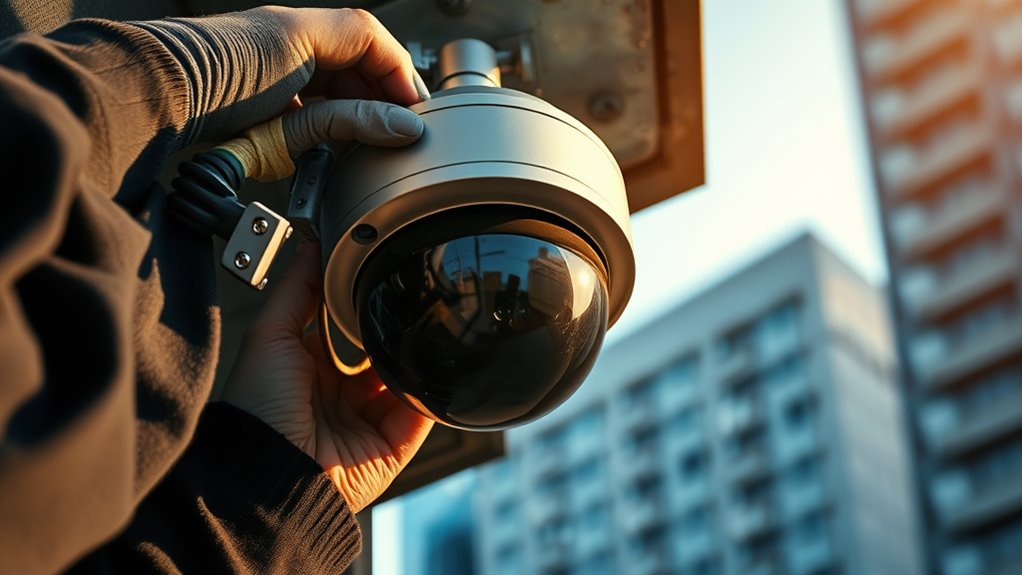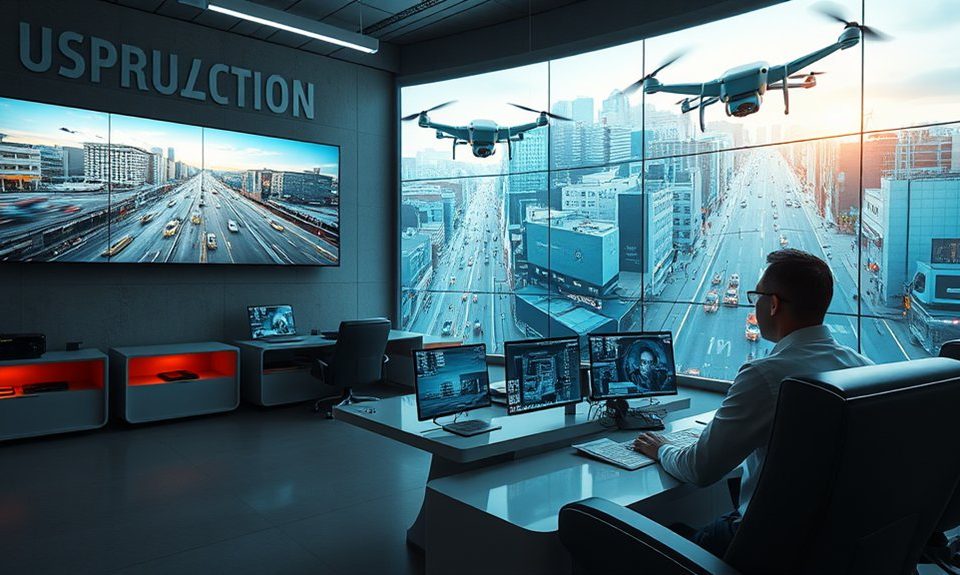Surveillance technology installation and deployment involves a structured approach to guarantee effective monitoring. It starts with evaluating vulnerabilities and risks within the environment. Proper equipment selection follows, considering types and budget. The layout must eliminate blind spots while factoring lighting and privacy. Connectivity is critical for real-time data, requiring reliable network architecture. Regular maintenance and timely upgrades enhance longevity. Further exploration into these aspects can provide more thorough insights into optimizing surveillance systems for security effectiveness.
Key Takeaways
- Assess vulnerabilities and risks to define the scope and purpose of your surveillance system effectively.
- Choose appropriate camera types and features based on budget and long-term operational goals.
- Plan camera layout for optimal coverage, considering blind spots, lighting, and privacy concerns.
- Ensure reliable connectivity and interoperability for seamless data transmission and system functionality.
- Schedule regular maintenance and upgrades to keep the surveillance system performing at its best.
Understanding Your Surveillance Needs

What factors should one consider when evaluating surveillance needs? The process begins with identifying vulnerabilities within the environment to be monitored. Understanding potential weak points aids in pinpointing where surveillance can be most effective. Next, evaluating risks is essential; one must assess the likelihood and impact of various threats. This includes considering external factors such as crime rates and internal dynamics like employee behavior. Additionally, the scope of surveillance should align with both the intended purpose and the specific context, whether for security, safety, or operational efficiency. Finally, compliance with legal and ethical standards must be taken into account, ensuring that surveillance measures respect privacy while effectively mitigating identified risks. Therefore, a thorough approach is necessary for informed decision-making. It’s crucial to remain aware of privacy concerns related to surveillance technology to ensure ethical practices are upheld.
Choosing the Right Equipment
Selecting appropriate surveillance equipment is a critical component in establishing an effective monitoring system. The choice of camera types—such as dome, bullet, or PTZ—must align with specific monitoring objectives. Each type offers distinct advantages, influencing coverage area, image clarity, and environmental resilience. Budget considerations play a pivotal role; higher-quality cameras often come with advanced features but require a substantial financial commitment. Consequently, a thorough assessment of both immediate needs and long-term goals is vital. Balancing performance and cost-effectiveness allows for ideal equipment selection without compromising security integrity. Ultimately, a meticulous evaluation of camera capabilities and associated expenses guarantees a tailored surveillance solution that meets the unique demands of the environment in question. Additionally, understanding bug sweep services can enhance the overall security strategy by ensuring that installed surveillance systems are not compromised by hidden threats.
Planning the Installation Layout
Effective surveillance equipment requires a well-thought-out installation layout to enhance performance and coverage. A meticulous approach to layout enhancement is essential, as it directly impacts the effectiveness of surveillance operations. Key spatial considerations include:
- Field of View: Guarantee overlapping coverage to eliminate blind spots.
- Camera Height: Position cameras at ideal heights for clear image capture.
- Lighting Conditions: Account for natural and artificial light to improve image clarity.
- Distance from Monitored Areas: Position equipment to maintain clarity without compromising privacy.
- Environmental Factors: Assess obstacles that may obstruct camera views.
Regular bug sweeps are also recommended to ensure that surveillance equipment remains secure from unauthorized access.
Ensuring Connectivity and Integration

While the physical layout of surveillance equipment plays an essential role in operational effectiveness, ensuring robust connectivity and seamless integration of all components is equally important. Achieving high network reliability is essential for maintaining real-time data transmission, which supports effective monitoring and response strategies. Network architecture must be designed to minimize latency and maximize bandwidth, thereby facilitating uninterrupted communication among devices. Furthermore, system interoperability is critical; different components must work cohesively to produce a unified surveillance solution. This requires compatibility across various platforms and standards, ensuring that data can be shared and analyzed efficiently. Attention to these aspects fosters a resilient surveillance environment, empowering users to respond swiftly to incidents while maintaining operational integrity. Additionally, leveraging professional private investigators can enhance the effectiveness of surveillance systems by providing expert insights and tailored investigation solutions.
Maintenance and Upgrades for Longevity
Although maintenance and upgrades are often overlooked, they are essential for guaranteeing the longevity and reliability of surveillance systems. Implementing a structured approach to preventive maintenance and timely software updates can greatly mitigate issues that arise from neglect.
Key practices include:
- Regularly inspecting hardware components for wear and tear.
- Performing software updates to address security vulnerabilities.
- Cleaning lenses and sensors to maintain image clarity.
- Testing and calibrating equipment to guarantee peak performance.
- Documenting maintenance activities for future reference.
- Engaging professionals for hidden camera detection can further ensure that your surveillance system remains unobstructed and effective.
Frequently Asked Questions
What Are the Legal Considerations for Installing Surveillance Cameras?
Legal considerations for installing surveillance cameras include understanding privacy laws and adhering to consent requirements. Organizations must guarantee compliance with regulations to mitigate risks associated with unauthorized recordings and potential invasion of personal privacy.
How Can I Ensure Privacy While Using Surveillance Technology?
To guarantee privacy while using surveillance technology, individuals should implement data encryption measures and obtain explicit user consent. These practices foster trust, mitigate risks of unauthorized access, and uphold ethical standards in surveillance operations.
What Are Common Security Risks Associated With Surveillance Systems?
Common security risks associated with surveillance systems include data breaches and system vulnerabilities. These weaknesses can expose sensitive information, compromise user privacy, and lead to unauthorized access, necessitating robust security measures to mitigate potential threats effectively.
How Do I Handle Power Outages Affecting Surveillance Equipment?
To manage power outages impacting surveillance equipment, guarantee implementation of backup power solutions and surge protection systems. This approach mitigates risks, maintaining operational integrity and safeguarding data during unexpected disruptions in electrical supply.
Can Surveillance Footage Be Accessed Remotely on Mobile Devices?
Surveillance footage can indeed be accessed remotely on mobile devices, provided the system supports remote access features. Ensuring mobile compatibility enhances user experience, allowing for convenient monitoring and real-time alerts from virtually anywhere.
Conclusion
To sum up, a successful surveillance technology installation and deployment requires a thorough understanding of specific security needs, careful selection of appropriate equipment, strategic planning of installation layouts, and ensuring robust connectivity and integration. Additionally, ongoing maintenance and timely upgrades are critical for maximizing system longevity and effectiveness. By adhering to these guidelines, organizations can establish a reliable surveillance framework that enhances safety and security while adapting to evolving technological advancements.




